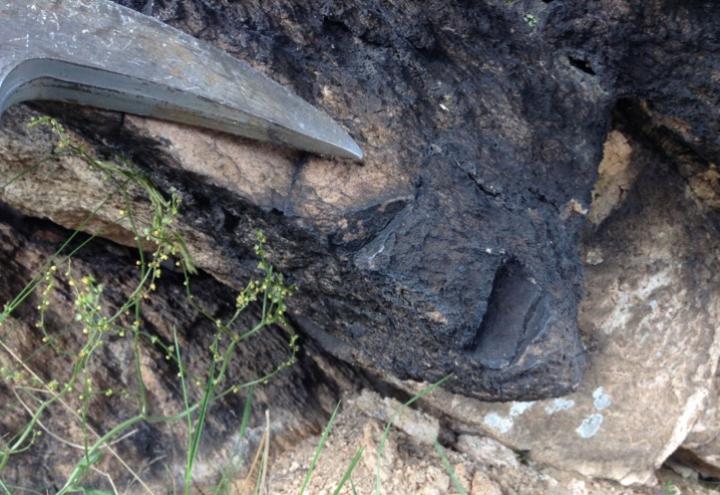Penn researchers quantify the changes that lightning inspires in rock

The study examined a rock fulgurite -- a thin layer of glass that forms when lightning strikes a rock's surface. The sample was collected from northern Italy's Mount Mottarone. Credit: Reto Gieré
In a new set of experiments at Penn, researchers have probed the power of lightning in a less risky but much more technologically advanced fashion.
Chiara Elmi, a postdoctoral researcher in Penn's Department of Earth and Environmental Science in the School of Arts & Sciences, led the work, which used a suite of techniques to examine a fulgurite, a thin layer of glass that forms on the surface of rock when lightning hits it.
Among other findings, the study discovered that, based on the crystalline material in the sample, the minimum temperature at which the fulgurite formed was roughly 1,700 degrees Celsius.
“People have been using morphological and chemical approaches to study rock fulgurites, but this was the first time a rock fulgurite was classified from a mineralogical point of view,” Elmi said. “I was able to adapt an approach that I've used before to study the effects of meteorite impact in rocks and sediments to analyze a tiny amount of material in order to understand the phase transitions that occur when a lightning hits a rock.”
Elmi collaborated on the work with senior author Reto Gieré, professor and chair of the Department of Earth and Environmental Science, along with the department's Jiangzhi Chen, a postdoctoral researcher, and David Goldsby, an associate professor.
Their paper will be published in the journal American Mineralogist.
In a study published last year, Gieré characterized a rock fulgurite found in southern France, finding that the lightning bolt that hit it transformed the layer of rock beneath the fulgurite on the atomic level, producing tell-tale structures called shock lamellae.
The team wanted to pursue a different line of study in the new work.
“In this case,” Gieré said, “we instead wanted to study the glass layer in more detail to find out what the minerals present could tell us about the temperature of lightning.”
To do so, Elmi performed an X-ray diffraction analysis, which collects information about the way that X-rays interact with crystalline materials to infer the mineral content of a given sample. The challenge in this instance, however, was that a typical X-ray diffraction analysis requires roughly a gram of material, and the quantity of the 10-micrometer thick fulgurite was not nearly that substantial.
To adapt the technique for a smaller quantity of sample, Elmi put the material in a narrow, rotating capillary tube and adjusted the diffraction optics to align, concentrate and direct the X-ray beam toward the sample. The analysis of the fulgurite revealed the presence of glass as well as cristobalite, a mineral with the same chemical composition of quartz but possessing a distinct crystal structure. Cristobalite only forms at very high temperature, and the glass indicated that the top layer of granite melted during the lightning strike. Elmi's analysis enabled her to quantify the glass and the residual minerals in a rock fulgurite for the first time.
“These two signatures indicate a system that received a shock of high temperature,” Elmi said. “This analysis also indicates the minimal temperature you have to create the glass because cristobalite forms around 1,700 Celsius, so you know that this temperature was achieved when the lightning hit the rock.”
The measured temperature of lightning in the air is in fact much higher — measured at around 30,000 degrees Celsius — but this analysis indicates that the rock itself was raised from ambient temperatures to at least 1,700 Celsius.
The team performed additional analyses on the fulgurite sample. They found organic material in the sample, indicating that the lightning burned lichen or moss growing on the surface of the rock and then trapped it inside the material.
“This is an extremely fast event,” Gieré said. “The rock heats up very quickly and also cools down very quickly. That traps gases in the glass and some of these gases were formed by the combustion of organic material.”
In future studies, the team hopes to develop a complete model of what happens to rocks during a lightning strike, incorporating chemical, physical, biological and mineralogical observations. They note that people like Franklin who experience near-misses with lightning are lucky indeed.
“It's amazing that a bolt of lightning can turn granite molten and completely change its structure, yet some people survive lightning strikes,” said Gieré.
Media Contact
All latest news from the category: Earth Sciences
Earth Sciences (also referred to as Geosciences), which deals with basic issues surrounding our planet, plays a vital role in the area of energy and raw materials supply.
Earth Sciences comprises subjects such as geology, geography, geological informatics, paleontology, mineralogy, petrography, crystallography, geophysics, geodesy, glaciology, cartography, photogrammetry, meteorology and seismology, early-warning systems, earthquake research and polar research.
Newest articles

Decoding Cancer: 40 Years of Breakthroughs in Genetic Research
Cancer in children and adolescents is rare. Nevertheless, malignant diseases are still one of the most common causes of death in this age group. Survivors of childhood or adolescent cancer…

Let’s Think Before the First Drink: How Early Substance Use Might Lead to Brain Structure Differences Among Adolescents
Many differences appeared to exist prior to any substance use, pointing to the role brain structure may play in substance use risk, NIH-supported study suggests. Studies reveal factors that expose…

Combating Kidney Cancer Using Enhanced Immunotherapies
Medical University of South Carolina Hollings Cancer Center researcher receives Department of Defense Early Career Scholar Award to improve immune therapies by targeting resistant kidney tumors. A Medical University of…



